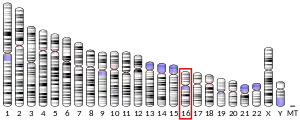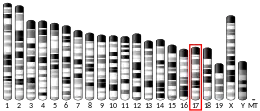Transcription factor SOX-8 is a protein that in humans is encoded by the SOX8 gene.[5][6][7]
This gene encodes a member of the SOX (SRY-related HMG-box) family of transcription factors involved in the regulation of embryonic development and in the determination of the cell fate. The encoded protein may act as a transcriptional activator after forming a protein complex with other proteins. This protein may be involved in brain development and function. Haploinsufficiency for this protein may contribute to the mental retardation found in haemoglobin H-related mental retardation (ATR-16 syndrome).[7]
See also
References
- 1 2 3 GRCh38: Ensembl release 89: ENSG00000005513 - Ensembl, May 2017
- 1 2 3 GRCm38: Ensembl release 89: ENSMUSG00000024176 - Ensembl, May 2017
- ↑ "Human PubMed Reference:". National Center for Biotechnology Information, U.S. National Library of Medicine.
- ↑ "Mouse PubMed Reference:". National Center for Biotechnology Information, U.S. National Library of Medicine.
- ↑ Pfeifer D, Poulat F, Holinski-Feder E, Kooy F, Scherer G (Apr 2000). "The SOX8 gene is located within 700 kb of the tip of chromosome 16p and is deleted in a patient with ATR-16 syndrome". Genomics. 63 (1): 108–16. doi:10.1006/geno.1999.6060. PMID 10662550.
- ↑ Schepers GE, Bullejos M, Hosking BM, Koopman P (Apr 2000). "Cloning and characterisation of the Sry-related transcription factor gene Sox8". Nucleic Acids Res. 28 (6): 1473–80. doi:10.1093/nar/28.6.1473. PMC 111037. PMID 10684944.
- 1 2 "Entrez Gene: SOX8 SRY (sex determining region Y)-box 8".
Further reading
- Daniels RJ, Peden JF, Lloyd C, et al. (2001). "Sequence, structure and pathology of the fully annotated terminal 2 Mb of the short arm of human chromosome 16". Hum. Mol. Genet. 10 (4): 339–52. doi:10.1093/hmg/10.4.339. PMID 11157797.
- Cheng YC, Lee CJ, Badge RM, et al. (2001). "Sox8 gene expression identifies immature glial cells in developing cerebellum and cerebellar tumours". Brain Res. Mol. Brain Res. 92 (1–2): 193–200. doi:10.1016/S0169-328X(01)00147-4. PMID 11483257.
- Strausberg RL, Feingold EA, Grouse LH, et al. (2003). "Generation and initial analysis of more than 15,000 full-length human and mouse cDNA sequences". Proc. Natl. Acad. Sci. U.S.A. 99 (26): 16899–903. Bibcode:2002PNAS...9916899M. doi:10.1073/pnas.242603899. PMC 139241. PMID 12477932.
- Gevaert K, Goethals M, Martens L, et al. (2004). "Exploring proteomes and analyzing protein processing by mass spectrometric identification of sorted N-terminal peptides". Nat. Biotechnol. 21 (5): 566–9. doi:10.1038/nbt810. PMID 12665801. S2CID 23783563.
- Schepers G, Wilson M, Wilhelm D, Koopman P (2003). "SOX8 is expressed during testis differentiation in mice and synergizes with SF1 to activate the Amh promoter in vitro". J. Biol. Chem. 278 (30): 28101–8. doi:10.1074/jbc.M304067200. PMID 12732652.
- Ota T, Suzuki Y, Nishikawa T, et al. (2004). "Complete sequencing and characterization of 21,243 full-length human cDNAs". Nat. Genet. 36 (1): 40–5. doi:10.1038/ng1285. PMID 14702039.
- Gerhard DS, Wagner L, Feingold EA, et al. (2004). "The Status, Quality, and Expansion of the NIH Full-Length cDNA Project: The Mammalian Gene Collection (MGC)". Genome Res. 14 (10B): 2121–7. doi:10.1101/gr.2596504. PMC 528928. PMID 15489334.
- Martin J, Han C, Gordon LA, et al. (2005). "The sequence and analysis of duplication-rich human chromosome 16" (PDF). Nature. 432 (7020): 988–94. Bibcode:2004Natur.432..988M. doi:10.1038/nature03187. PMID 15616553. S2CID 4362044.
- Wissmüller S, Kosian T, Wolf M, et al. (2006). "The high-mobility-group domain of Sox proteins interacts with DNA-binding domains of many transcription factors". Nucleic Acids Res. 34 (6): 1735–44. doi:10.1093/nar/gkl105. PMC 1421504. PMID 16582099.
This article is issued from Wikipedia. The text is licensed under Creative Commons - Attribution - Sharealike. Additional terms may apply for the media files.



